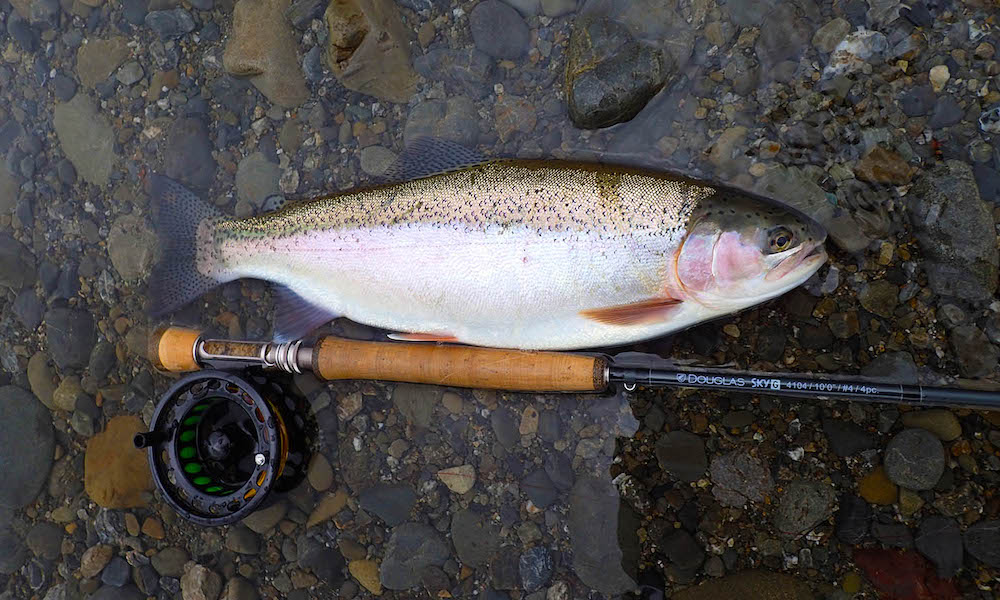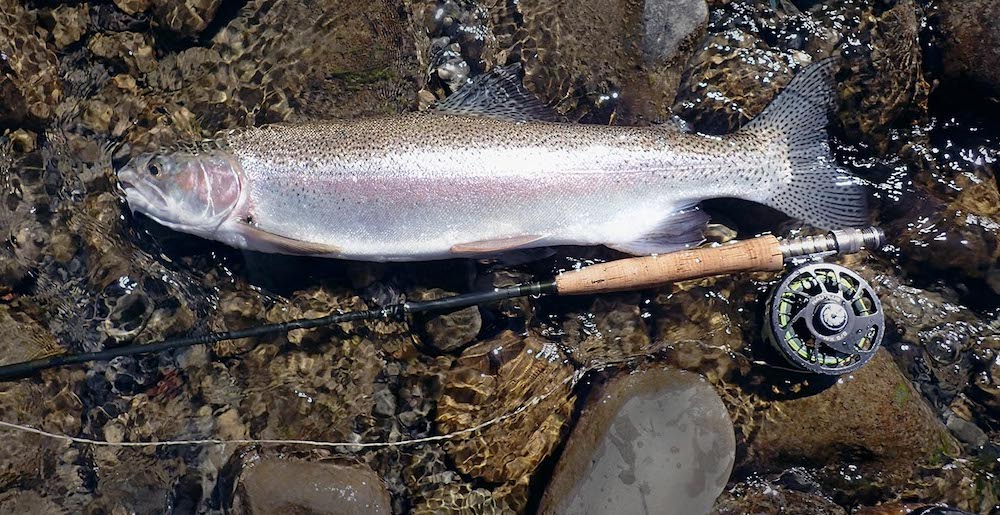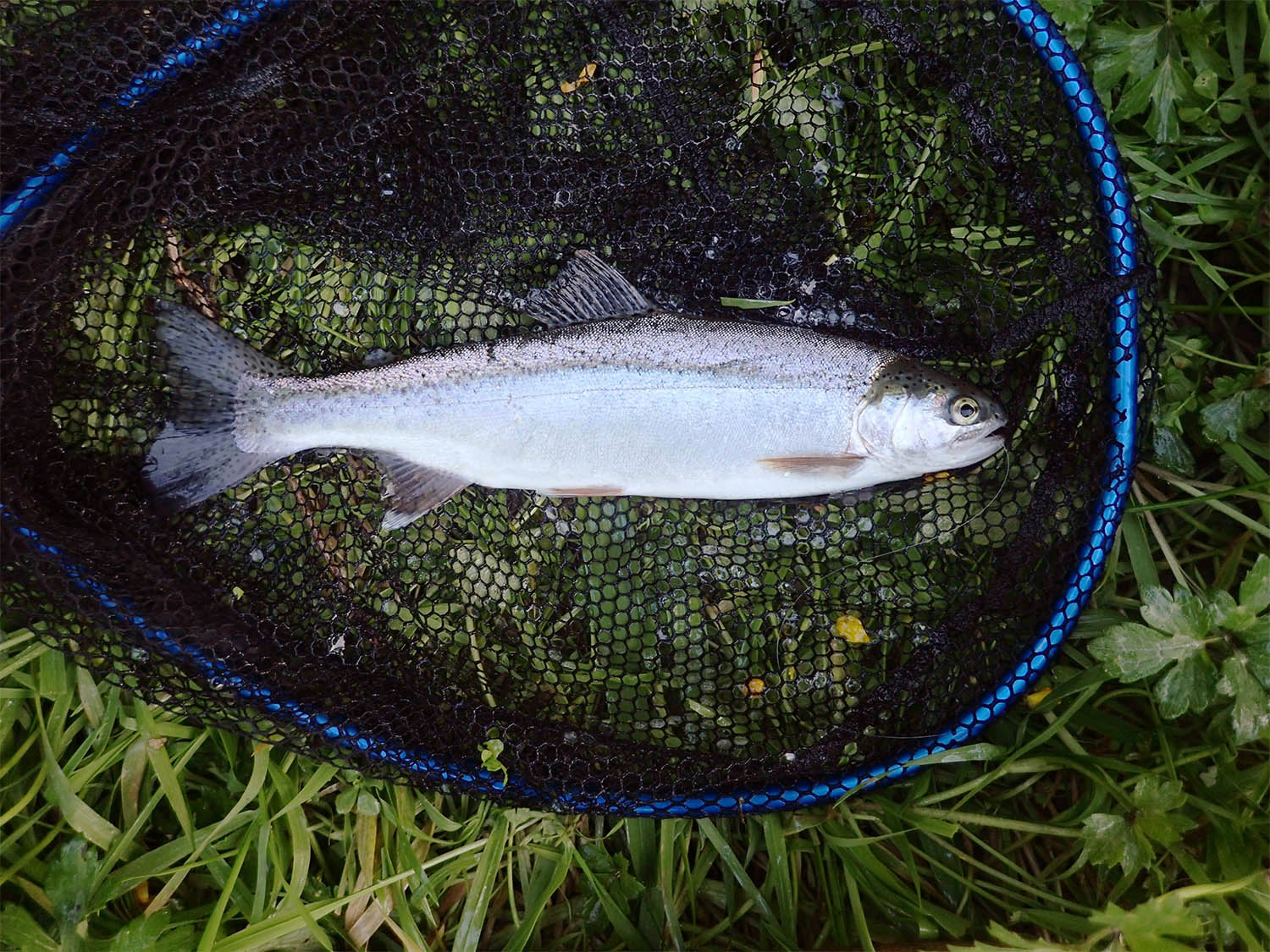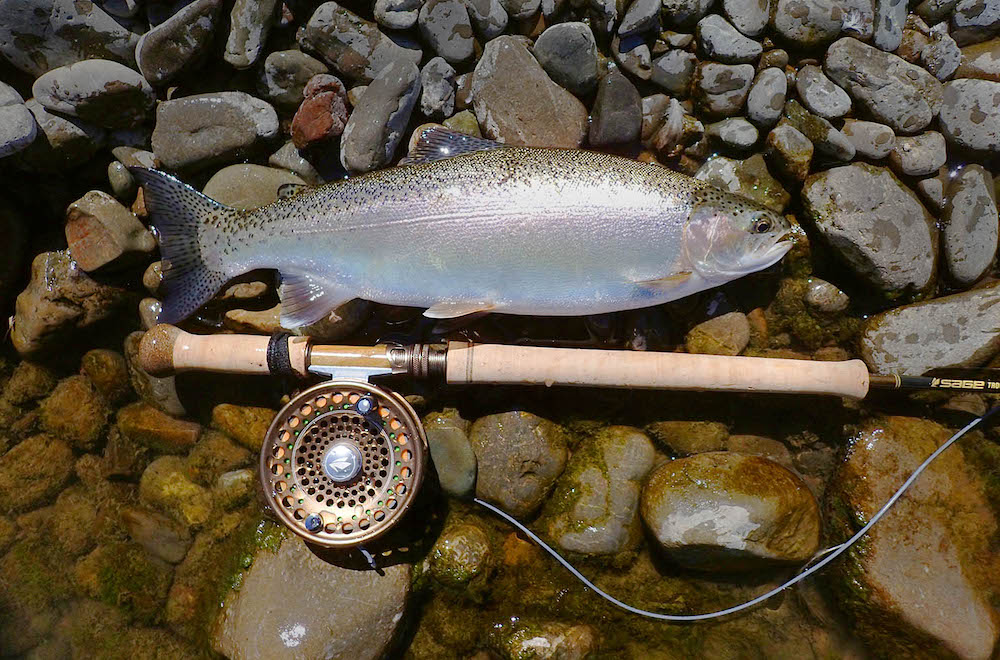Why I believe there are sea-run rainbow trout in New Zealand rivers
Rainbow trout, Oncorhynchus mykiss, are members of the Pacific salmon genus, Oncorhyncus, which includes five other species of salmon.
The term ‘steelhead’ traditionally refers to rainbow trout that hatch in rivers then spend time feeding and growing in the ocean, returning to their natal rivers to spawn which is known as an anadromous or sea-going life-style.
After the introduction of rainbow trout to the Great Lakes of North America, the term ‘steelhead’ was somewhat contentiously extended to include those powerful chrome rainbows that use large deep lakes as traditional steelhead use the sea, i.e. as a rich feeding ground.
The silver rainbows feeding on smelt in Lake Taupo and running up the Tongariro river and other Lake Taupo tributaries to spawn fit squarely into this expanded definition.
The term sea trout could theoretically apply to any anadromous trout species, but it is usually reserved for sea-run brown trout.
While New Zealand has good populations of sea trout and king salmon, it has long been accepted that we have no sea-run rainbows. This is thought to be because steelhead move further from the coast than brown trout and king salmon, and those rainbow trout that go far out into the salt do not find their way back home from a hostile ocean.
However not all ocean-going rainbow trout spend several years at sea a long way from shore before returning as monster steelhead. Recent captures have convinced me that some New Zealand rivers receive modest sized steelhead that have spent a year or less in the salt.
Some interesting captures
In October 2023 I was fishing the tidal reaches of the Otaki River about a kilometre from the mouth, when I hooked and landed a fat, chrome 14.5 inch rainbow trout and also several sea-run brown trout, i.e. sea trout. With its dark blue/black back and bright silver flanks, this rainbow looked for all the world like a miniature version of the fresh-from-the-sea steelhead I’d long envied catching and seen in photos from coastal rivers of the north west Pacific.
As there is no resident population of rainbow trout in the Otaki River and there’s also no estuary as such, there’s a fightingly good chance this fish came in from the sea - and was a proper steelhead, i.e. a trout that has spent time in the ocean instead of in a large lake.

The rainbow trout that started me thinking - lower Otaki River October 2023

A sea trout that was caught at the same time as the rainbow trout above
Intrigued by the appearance and likelihood of this modest-sized rainbow trout’s ocean-going origin I performed a taste test. The flesh was bright orange, smelled of the sea and tasted just like salmon, both raw and cooked, with none of the muddy flavour associated with river resident fish.
Trout flesh becomes orange when they eat crustaceans such as krill, crabs, shrimps and crayfish, or by eating baitfish that feed on zooplankton containing high levels or carotenoids, like trout in Lake Taupo that eat smelt feeding on cladocerans.
Whereas river-dwelling trout that feed on insects and baitfish that feed on insects , such as bullies and torrent fish, tend to have white flesh. Trout with orange flesh found in rivers that flow into the ocean have therefore usually been feeding in the sea.
Another observation suggesting that my silver rainbow trout very likely came in from the sea, is that just like the sea trout I caught it with, its scales easily dislodged into my net and on my hands as tiny chrome sequins.
In the ensuing weeks I caught two more well-conditioned silver rainbows, this time 2 km and 4 km respectively from the river mouth. At 16.5 and 19 inches they were larger than the first fish, and although they also had blue/black backs, loose scales and silvery sides with few spots below the lateral line, both had a faint flush of pink along each flank.
The black spots and pale pink bands on these trout were significantly darker in the small patches where the silver scales had been shed. The opaque chrome scales therefore lightened the band and spots, much the same as they do with black spots on a sea trout.
These two trout also had bright orange flesh and tasted like salmon.

Two more examples of fat silver rainbows from the lower reaches of the river


The black dots and pale pink band along the flank of this 19 inch silvery rainbow jack are much darker where the loose chrome scales are missing. The scales came off in my landing net.

Typical flesh colour of silvery rainbows from the lower part of the river
In late January 2024, I caught a 23.5 inch 5 lb rainbow trout in the middle reaches of the Otaki River about 11 km from the river mouth. This fish had more colour than those I caught in the lower reaches of the river earlier in the season. But the slender shape and large tail suggested it was a steelhead that had been in the river for a month or two. This fish I released.

A 23.5 inch rainbow from the middle reaches of the river
In August 2024, when looking for sea trout in a river dropping from a substantial flood, I caught a superbly conditioned silvery 20 inch rainbow in the short tidal section of the Otaki River. Its stomach contained a few small insect nymphs as well as a marine crab. The colour and condition of the fish, the fact that it was caught near the mouth on a dropping river, and the presence of a marine crab in its stomach all suggest it had recently come in from the sea.
In October 2024 I caught a 19 inch fat silvery rainbow jack about 5 km from the mouth on a nymph and in November 2024 I caught 18 and 13 inch rainbow hens on a jig streamer 2 and 3 km from the mouth, respectively.
Like all of the other rainbows they were caught on a dropping river amongst sea trout. I mention these captures to demonstrate that although not common, silver rainbows with loose scales show up regularly in the lower reaches of the Otaki River, particularly in spring and early summer.
All of the rainbows I caught were incredibly powerful and acrobatic for their size. They had also all been feeding in the river, mostly on a wide range of aquatic insects with horned caddis and Dobson fly larvae being most common. The presence of marine crab remains in the stomachs of two of them indicated that they had also fed in the sea.
This is by no means the first season rainbow trout that have been observed in the lower Otaki River. In 2015 and 2016 I caught a few and Andrew Harding also featured a couple from this period in a video he posted online. At the time I, perhaps incorrectly, assumed these fish were escapees from a stocking of Winstone’s Quarry Lake, a quarry reservoir a few hundred meters from the Otaki River bed.

A silvery 15 inch rainbow trout from the lower Otaki in August 2016
Its also worth noting that in October of 2021 and 2022 and in November 2024, I caught three bright silver 10-12 inch rainbows in the lower reaches of the Waikanae River, a small stream 12 km south of the Otaki River mouth, which also does not have a resident rainbow trout population.

Waikanae river Rainbow: A 12 inch Waikanae river rainbow caught in November 2024
Comparison with North American Steelhead
Extensive research on rainbow trout in north-west North America and the Kamchatka Peninsular in Russia revealed O. mykiss are very ‘plastic’, ie adaptable, in regard to the proportion of a population that is anadromous (sea-going).
The proportion of each population going to sea may vary from 0-100% and is determined largely by environmental factors like river food availability, summer temperatures and survival rates at sea.
The amount of time anadromous individuals spend in the ocean was also found vary substantially between populations.
Steelhead are usually classified according to the number of years they spend in the ocean before returning to the rivers in which they were spawned, e.g. 1 year at sea is a one-salt fish, and 2 years at sea a two-salt fish etc. Time spent at sea is often population specific and those fish spending more time in the salt are larger when they return to fresh water. The largest fish spend around 4 years in the sea.
Half-pound steelhead are sea-run rainbows that have spent a year or less in the ocean, and they tend to stay closer to the coastline than those steelhead spending several years at sea. Despite the name ‘half-pound steelhead’ these trout usually average between 1 to 6 lbs.
American half-pound steelhead are immature fish that enter rivers in winter but return to the ocean in spring. It is believed they do this to not be eaten in the ocean, which is less safe than the rivers they frequent during winter.
Since the steelhead I landed in the Otaki River were caught with sea trout of a similar size, in the spring and early summer, it’s fair to assume that the lower reaches of this river are a good place for sea-run trout at this time of year.
During spring in New Zealand, sea trout supposedly follow swarms of whitebait - juvenile inanga, a native anadromous galaxiid fish - swimming into the lower reaches of many rivers. At this time of year common bullies aggregate in the lower reaches to spawn and there are usually smelt and juvenile mullet around as well as aquatic insects like mayfly nymphs and caddis larvae. The lower reaches of New Zealand rivers therefore hold plenty of food in spring.
The trout that I caught had all been eating some or most of the above mentioned food items. However, unlike the sea trout, which often contained bullies or torrent fish, I found no fish remains in the stomachs of the rainbows.
I should also mention that whitebait were seldom found in the stomachs of sea trout, even when there was plenty of whitebait about, which casts some doubt on the ‘following whitebait’ theory. There may nevertheless be more food in the river than in the sea in spring.
Another reason steelhead may enter the Otaki River in spring is because there are fewer predators present than in the ocean. Predators in the river include eels and shags (cormorants), whereas in the ocean, trout need to take their chances with voracious seals, sharks, gannets, shags and swift predatory fish like barracouta and kingfish.
Strays
Most Pacific salmon, including steelhead, return to the river in which they hatched but there’s a small proportion known as strays or vagrants that enter a completely different river system when they return to fresh water.
Research on wild populations in their native range has shown that the numbers of steelhead straying to neighbouring water sheds is higher for immature 1-salt fish (half-pounders) than for mature fish returning to spawn.
Rainbow trout deliberately introduced to rivers on the east coast of Canada are known to go out to sea and then ‘invade’ nearby rivers that don’t have established populations of rainbows - which is what I believe is occurring in the Otaki and Waikanae rivers.
While the rainbows sporadically entering the Otaki and Waikanae rivers are very likely steelhead strays, what we don’t know is whether they return to the ocean, like American half-pounders, or they remain in the rivers.
The presence of steelhead strays in a river without an established rainbow trout population does not necessarily mean they leave, as rainbows failed to reproduce in many New Zealand rivers into which they were introduced.
That said, having fished the upper Otaki River and its major tributary, 30-40 km from the mouth, extensively over the last 16 years, particularly in February and March, I‘ve seen only one rainbow amongst many hundreds of brown trout caught in that part of the river. That rainbow was a 4lb jack taken by Dan Thomas in February 2017.
The very rare occurrence of larger sized rainbow trout in the middle and upper reaches of the Otaki River in spring and early summer, suggests that most smaller fish (less than 20 inches) found in the lower reaches probably return to the ocean, instead of making their way further upriver.
Steelhead populations in New Zealand?
I suspect the steelhead strays entering my local rivers originated from the Manawatu or Rangitikei rivers, 34 and 54 km north of the Otaki River mouth, respectively. Both of these large rivers have substantial well-established rainbow trout populations with easy unimpeded access to the sea.
One has to ask whether some of the New Zealand rainbows entering the sea return to their natal rivers and that permanent populations of steelhead may have been established, even if they are only a small proportion of an overall rainbow trout population in each river. Fisheries biologists refer to co-existing resident and anadromous populations of fish as being ‘sympatric’ populations.
We can safely rule out the possibility of steelhead populations that spend more than a year at sea, because if they existed they would be obvious from the annual runs of larger silver fish returning to the river each year. The presence of populations of 1-salt fish of 1.5 to 4lb, on the other hand, are likely to be harder to identify.
A good bag of fat and unusually powerful 15 inch silvery rainbows caught swinging streamers in two pools of the Manawatu River around Ashhurst in March one year, have certainly got me thinking about whether they could have been half-pound steelhead. I unfortunately did not keep any of these fish, so can’t comment on flesh colour.

Could this Manawatu Rainbow Trout, one of several of similar size and proportion, have been a steelhead?
In addition to the Manawatu and Rangitikei rivers, many others around New Zealand have rainbow trout in the lower reaches that could potentially have anadromous populations. On the North Island these include rivers around the Taranaki ring plane and the Tukituki and Mohaka rivers in Hawk Bay. On the South Island there are the Pelorus, Waimakariri, Rakaia, Rangitata and Waitaki rivers.
Most of these rivers have good runs of sea trout, and it is possible that 1-salt rainbows remain close to the coast, essentially hanging out with the sea trout.
There is a widely held theory that New Zealand sea-run brown trout may associate with freshwater plumes in the ocean, generated by the frequent flood events, so that they don’t have to complete the arduous process of switching completely from freshwater to saltwater osmoregulation.
These fish theoretically move in and out of the lower reaches of rivers, following the expansion and contraction of the plumes and relative food available in both the ocean and the lower river. This theory would explains why sea trout are caught throughout the year in New Zealand, and not just when they return to spawn.
Since several rivers generally contribute to a freshwater plume generated after a flood, the trout associated with that plume would not be restricted to one catchment. In other words fish entering the ocean from one catchment could return to freshwater in another, especially if the the plume was driven down the coast, as is often observed with flood water, before dissipating.
Anecdotal evidence of steelhead in other systems
Many of the rainbows from the Waimakariri that I’ve seen in videos and photographs were bright silver fish in the 1.5 to 3.5 lb range that looked exactly like the lower Otaki fish I caught and could easily have been 1-salt steelhead.
I’ve also read that in winter there is good fishing for small rainbows of 1.5-3.5 lb in the middle and lower reaches of the Waitaki and Waimakariri rivers, and I’ve seen a video of such a rainbow caught on spinning gear just 100m from the Waitaki River mouth.
Perhaps rainbows come in from the salt in winter on South Island east coast rivers? This would explain why in spring and summer when sea trout and salmon anglers fish these river mouths and estuaries, they don’t catch steelhead. If this were the case then we would expect different biological/environmental drivers to those at play for fish entering my local rivers, e.g. they could be returning to natal rivers in winter to spawn.
During his time as fishing guide, Steve Gerard (owner of Flyshop NZ) and his clients caught several large 8-9lb rainbows in spring creeks flowing into the Rakaia and Rangitata rivers during summer. The big fish tended to be well proportioned, indicating a good supply of food throughout their growth period, suggesting the possibility of being sea-run. When comparing these with other smaller rainbow trout in the same spring creeks, the smaller fish would often be short but fat, indicating that at certain stages during their lives food had been scarcer, and then more abundant, as you would expect of fish living solely within in the braided river environments of east coast rivers.
The role of science
To prove that anadromous or sea-going fish are present within a population of rainbow trout would require some science.
Anadromous brown and rainbow trout usually go to sea when they’re 1-3 years old. To survive in salt water they undergo physiological changes, known as smoltification. Once this process is complete the individuals, usually 5-8 inches long, become bright silver.
While the presence in rivers of schools of bright silver 5-8 inch long rainbows, usually in spring, may indicate anadromy, there is no guarantee these fish will return to their natal rivers. The presence of smolts is, nevertheless, part of the puzzle - no smolts equals no migration to sea.
The three methods commonly used to identify fish returning from the salt are:
1. Microscopic examination of scales: A large growth check/band on the scales of returning fish indicates a period of rapid growth in the ocean. This method is the cheapest but least conclusive, as the growth checks are often difficult to identify, especially for individuals spending less time at sea.
2. Stable Isotope Analysis of scales or other tissue: Stable isotopes are stable forms of an atom with different numbers of neutrons. Based on the different sources of carbon and nitrogen in the marine and terrestrial food that trout eat, their scales usually show different ratios of the stable isotopes of each of these two atoms, e.g. 15N vs 16N and 13C vs 12C. Fish that have recently fed in the ocean usually have more 15N and 13C in their scales than fish feeding in rivers. A disadvantage of this method is that sea-run fish feeding in rivers have an isotope ‘signature’ that will change over time to resemble those of resident fish.
3. Otolith trace element analysis.
Otoliths, or ear stones, are calcium carbonate structures found within the skulls of fish and are used for both hearing and balance. Because different forms of the material are deposited when fish are growing fast (summer) and slow (winter), otoliths contain growth rings, similar to a tree, and may be used for ageing. By analysing the ratios of certain trace elements in each growth zone one can determine where a fish has been at different stages of its life. A higher Strontium to Calcium ratio usually indicates a period in salt or brackish water. Because otoliths are stable structures, without a blood supply, they contain a permanent record of a fish’s past.
Conclusion
The occasional capture of bright silver rainbow trout in the lower reaches of the Otaki and Waikanae rivers has convinced me that we do have sea-run steelhead in New Zealand, even if they are strays. Based on the size of these steelhead they appear to be fish that have spent a year or less in the salt.
To determine if self-sustaining populations of steelhead occur in some New Zealand rivers would require further investigation and due scientific process. In the meantime, the more anglers on the lookout and with clear photographic/video evidence of smolts and schools of silver 1-3 pounds fish returning from the sea, the more likely we are to find them, should they exist.
Wouldn’t it be great knowing we had steelhead in certain New Zealand rivers, even if they aren’t the monster fish of the Pacific north west?
P.S. To determine whether steelhead enter New Zealand rivers, since August 2024 I've been collecting scales and otoliths from sea-run brown and rainbow trout from the Otaki River. These otoliths and scales I've sent to Dr Rasmus Gabrielsson of Fish and Game NZ who is undertaking their trace element analysis. We hope to determine, firstly, the age of these fish, secondly, when they entered the ocean and, thirdly, for how long and which seasons they typically spent there. There's also a chance the chemical composition of the otolith cores will tell us which New Zealand rivers they were spawned in.
See this space for updates.
Further Reading :
Kendall N.W., McMillan J.R., Sloat M.R., Buehrens T.W., Quinn T.P., Pess G.R., et al. 2015. Anadromy and residency in steelhead and rainbow trout (Oncorhynchus mykiss): a review of the processes and patterns. Can. J. Fish Aquat. Sci. 72(3): 319–342.
Roloson S.D., Knysh K.M., Coffin M.R.S., Gormley K.L., Pater C.C., and van den Heuvel M.R. 2018. Rainbow trout (Oncorhynchus mykiss) habitat overlap with wild Atlantic salmon (Salmo salar) and brook trout (Salvelinus fontinalis) in natural streams: do habitat and landscape factors override competitive interactions? Can. J. Fish. Aquat. Sci. 75(11): 1949–1959.
